NUDE, c.1950
John Passmore
oil on canvas
91.0 x 67.0 cm
signed with initials lower right: JP
Estate of the artist, Sydney
Private collection, Sydney
The nude is one of the truly great subjects in the history of Western Art, ranging in sculpture from the Greek masterpiece of Venus de Milo in The Louvre to the supremely Renaissance figure of David by Michelangelo. In paint, the frescoed nudes of Pompeii, Botticelli, Titian, and Velázquez all claim our attention, as do the sensuously seductive paintings of Modigliani. Everybody has their favourites; and the twentieth century would have been only half itself without the nudes of Picasso. One of the best books ever written on art is devoted to the subject, Kenneth Clark writing that, 'the naked human body was the central subject of art.'1 As all artists know, the life class is as central to art as reading is to learning. In Australia Norman Lindsay made the nude female figure his own; while figure drawings by Rupert Bunny and Godfrey Miller are master works in their own right. As the figure played a central role in Passmore's art, what did he make of the nude? He believed, in his own words, the model to be the 'eternal generator of man's consciousness'; even attending John Henshaw's life drawing classes at the National Art School after his retirement.2
In Nude Passmore creates the sense of form through the use of colour rather than tone, the geometric patchwork of colours and their juxtapositions adding to its enhancement. The analogy with music in the scaling of the colours and application of paint reflects Passmore's interest in classical music, particularly Beethoven, Mozart, and Berlioz. It gives the whole composition a mobility and vitality, although the motif itself is immobile. Commenting on the figure, Passmore said:
'...It seems to me, by depersonalising my models, by placing them all in a very general plane as elementary human figures, I am helping to set in motion some indefinable mechanism of imagination and stimulation and so greatly increasing the power of the effigy.'3
Passmore believed that art should be a mystery: 'When all is discovered ... the Goddess is lost!'4 A revered and brilliant teacher, he was, nevertheless, a bit of a mystery himself, reclusive and enigmatic. The artist Hurtle Duffield in Patrick White's The Vivisector was based partly on Passmore.
1. Clark, K., The Nude, A Study in Ideal Form, Princetown University Press, eight printing, 1990, p.3
2. Pinson, P., John Passmore - the late works, Ivan Dougherty Gallery, University of Sydney, 1997, p.24
3. Passmore, quoted in Pinson, ibid
4. Ibid, p.11
DAVID THOMAS
